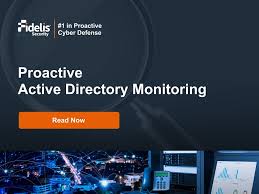The Importance of Active Directory Monitoring
Active Directory (AD) is a crucial component of most modern IT infrastructures, serving as the central hub for managing user accounts, permissions, and access to resources. As organisations rely heavily on AD for their daily operations, ensuring its security and integrity is paramount. This is where active directory monitoring plays a vital role.
What is Active Directory Monitoring?
Active Directory monitoring involves the continuous tracking and analysis of activities within the AD environment. It provides real-time visibility into user actions, system changes, authentication events, and more. By monitoring AD effectively, organisations can detect suspicious behaviour, prevent security breaches, and ensure compliance with regulatory requirements.
The Benefits of Active Directory Monitoring
Enhanced Security: By monitoring user activities and system events in real-time, organisations can quickly identify potential security threats such as unauthorised access attempts or unusual account behaviour.
Improved Compliance: Many industry regulations require organisations to maintain strict control over their IT systems. Active directory monitoring helps in demonstrating compliance by providing detailed audit trails and reports of all activities within AD.
Proactive Incident Response: With active directory monitoring in place, IT teams can proactively respond to security incidents before they escalate. Immediate alerts and notifications enable swift action to mitigate risks and minimise potential damage.
Best Practices for Active Directory Monitoring
- Define Monitoring Objectives: Establish clear goals for AD monitoring based on your organisation’s security policies and compliance requirements.
- Implement Real-Time Alerts: Configure alerts to notify administrators of suspicious activities or critical events as they occur.
- Regularly Review Logs: Analyse audit logs and reports regularly to identify trends, anomalies, or potential security issues.
- Audit User Permissions: Monitor user permissions and access rights to prevent privilege abuse or unauthorised changes.
- Update Monitoring Tools: Keep your monitoring tools up-to-date to ensure they can effectively capture and analyse AD data.
In Conclusion
Active directory monitoring is an essential practice for maintaining the security, compliance, and efficiency of your IT infrastructure. By investing in robust monitoring solutions and following best practices, organisations can safeguard their Active Directory environment against threats and vulnerabilities while ensuring smooth operations.
Top 5 Essential Tips for Effective Active Directory Monitoring
- Regularly review audit logs for any suspicious activities.
- Set up alerts for critical events such as password changes or failed login attempts.
- Monitor the replication status to ensure data consistency across domain controllers.
- Implement group policy monitoring to track changes in security settings.
- Use performance monitoring tools to detect and troubleshoot issues proactively.
Regularly review audit logs for any suspicious activities.
Regularly reviewing audit logs for any suspicious activities is a crucial aspect of effective Active Directory monitoring. By diligently examining these logs, organisations can promptly identify anomalies, unusual patterns, or potential security breaches within their AD environment. This proactive approach not only helps in mitigating risks but also enhances the overall security posture by enabling swift responses to any suspicious behaviour. Maintaining a vigilant eye on audit logs is key to ensuring the integrity and robustness of the Active Directory infrastructure.
Set up alerts for critical events such as password changes or failed login attempts.
Setting up alerts for critical events such as password changes or failed login attempts is a key tip in active directory monitoring. By configuring notifications for these specific activities, organisations can promptly detect and respond to potential security threats. Password changes and failed login attempts are often indicators of malicious intent or unauthorised access attempts. With alert mechanisms in place, IT teams can take immediate action to investigate suspicious behaviour, strengthen security measures, and safeguard the integrity of their Active Directory environment.
Monitor the replication status to ensure data consistency across domain controllers.
Monitoring the replication status is a critical aspect of active directory monitoring to maintain data consistency across domain controllers. By regularly checking the replication status, IT administrators can ensure that changes made on one domain controller are promptly and accurately propagated to others. This proactive approach helps prevent discrepancies or data conflicts within the Active Directory environment, ensuring that all domain controllers are in sync and operating effectively.
Implement group policy monitoring to track changes in security settings.
Implementing group policy monitoring is a crucial tip for effective Active Directory monitoring. By tracking changes in security settings through group policy monitoring, organisations can ensure that any modifications to access controls, permissions, or configurations are captured in real-time. This proactive approach not only helps in identifying potential security breaches but also allows administrators to maintain a secure and compliant Active Directory environment. Group policy monitoring provides valuable insights into who made the changes, when they were made, and what specific settings were altered, enabling swift response to any unauthorised or suspicious activities.
Use performance monitoring tools to detect and troubleshoot issues proactively.
Utilising performance monitoring tools is a valuable tip for effective Active Directory monitoring. By leveraging these tools, organisations can proactively detect and troubleshoot issues within their AD environment before they escalate. Performance monitoring tools provide real-time insights into system performance, resource usage, and potential bottlenecks, allowing IT teams to address issues promptly and optimise the overall health of their Active Directory infrastructure.

